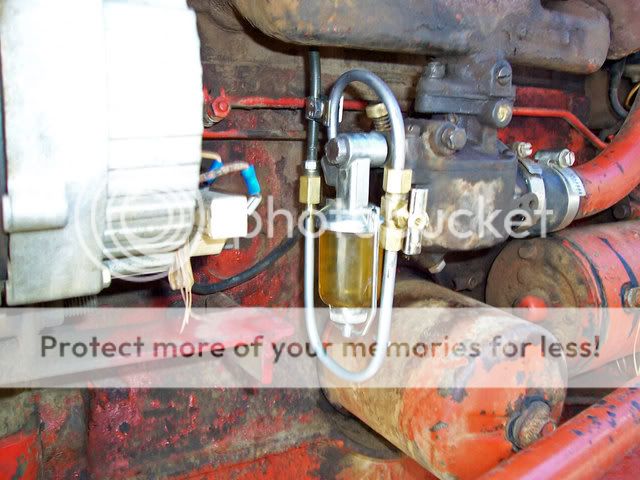I need help. My 960 has run terrific this year. I rebuilt the hydraulic pump last winter and put in a new pressure valve, adjusted everything in the hydraulics.
Three weeks ago I notice the hydraulics acting flaky. Slow lift, jerky. So I"m revving the engine to get it to lift faster, but then it stops lifting at all. I throttle the engine back down, and it starts sounding like a sick calf. ???
The hydraulic problem was easy to fix - the pump bolts had worked loose and it lost prime. Fixed that. But I can"t figure out what happened to the engine. Here"s what I"ve tried:
- Carb rebuild
- Compression check (all around 150)
- air intake checked for obstructions (nothing)
- exhaust checked for the same (nothing)
- bubbles in radiator? (nothing)
- plugs replaced with new gapped plugs
- new wires
- new coil
- took out distributor and found nothing wrong with it (more on this in a bit)
So I think it"s timing/ignition, but I"m not sure. I can get it to start, but it"s hard. All the plugs spark fine. Sometimes I can get it to run completely normally, but only for about 5 minutes, then it chokes back to the sick calf mode. When it"s running, I"ve set the carb screws to make sure that"s not a problem. When it gets in sick mode, I can sometimes manually change the timing (turn distributor) and get it to run again, sometimes I can"t. How warmed up it is doesn"t seem to make a difference. I don"t think there"s anything wrong with the gas either. It was empty today so I gave it 5 gallons of fresh gas, no difference.
When I worked on the distributor, I cleaned a bit of carbon off the posts & the end of the rotor. Someone suggested a bad condenser, but I found out this distributor has a Pertronix Ignitor ignition. So nothing to adjust there. I checked the distributor advance weights and gave them a little lube, but they seemed fine.
I couldn"t actually set the timing properly. I borrowed a timing light today, and couldn"t find the timing marks on the flywheel. Hand turned it the whole way round twice and couldn"t find them. But the timing light worked fine. I even tried it on the other plug wires and it worked on all of them.
Any ideas?
Three weeks ago I notice the hydraulics acting flaky. Slow lift, jerky. So I"m revving the engine to get it to lift faster, but then it stops lifting at all. I throttle the engine back down, and it starts sounding like a sick calf. ???
The hydraulic problem was easy to fix - the pump bolts had worked loose and it lost prime. Fixed that. But I can"t figure out what happened to the engine. Here"s what I"ve tried:
- Carb rebuild
- Compression check (all around 150)
- air intake checked for obstructions (nothing)
- exhaust checked for the same (nothing)
- bubbles in radiator? (nothing)
- plugs replaced with new gapped plugs
- new wires
- new coil
- took out distributor and found nothing wrong with it (more on this in a bit)
So I think it"s timing/ignition, but I"m not sure. I can get it to start, but it"s hard. All the plugs spark fine. Sometimes I can get it to run completely normally, but only for about 5 minutes, then it chokes back to the sick calf mode. When it"s running, I"ve set the carb screws to make sure that"s not a problem. When it gets in sick mode, I can sometimes manually change the timing (turn distributor) and get it to run again, sometimes I can"t. How warmed up it is doesn"t seem to make a difference. I don"t think there"s anything wrong with the gas either. It was empty today so I gave it 5 gallons of fresh gas, no difference.
When I worked on the distributor, I cleaned a bit of carbon off the posts & the end of the rotor. Someone suggested a bad condenser, but I found out this distributor has a Pertronix Ignitor ignition. So nothing to adjust there. I checked the distributor advance weights and gave them a little lube, but they seemed fine.
I couldn"t actually set the timing properly. I borrowed a timing light today, and couldn"t find the timing marks on the flywheel. Hand turned it the whole way round twice and couldn"t find them. But the timing light worked fine. I even tried it on the other plug wires and it worked on all of them.
Any ideas?


